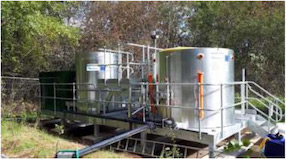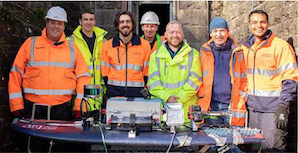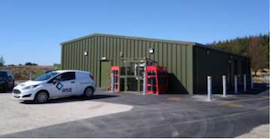Hydro Nation: annual report 2020
Records the development of Scotland's Hydro Nation policy agenda and reports on progress since the publication of the sixth annual report in 2019.
National: Supporting Communities and Scotland’s Water Economy
Scotland is a Hydro Nation, one that views and manages its water resources responsibly, and views our relationship, and the ways we work, with the water environment and industry as inextricably linked to our national identity.
Our water sector, including Scottish Water, is worth an estimated £1.7 billion[1] to the Scottish Economy. We are committed to the sector’s growing success and will work with our enterprise agencies and Scotland Development International to support our businesses into new markets. The examples below help to underline how the Hydro Nation agenda is delivering in Scotland, and for Scotland.
Scottish Water: Delivering for You
Scottish Water continues to invest and deliver infrastructure that is fit for communities throughout the country now and for decades to come through its £3.9 billion capital programme for the 2015-21 period.
Virtual Inspections: In response to the Covid-19 pandemic, Scottish Water’s Field Response teams started using WhatsApp to connect with customers in self-isolation in April 2020. Every day, Field Response teams are out supporting customers and resolving issues such as loss of normal supply or low water pressure. However, as the country entered lockdown, and many people self-isolated due to Covid-19 symptoms, carrying out normal face-to-face visits became trickier for frontline staff. As a solution, some Network Service Operators (NSOs) began diagnosing customer problems via WhatsApp video calls - to help keep staff, and customers, safer.

Using WhatsApp also benefited Scottish Water because some workers were among those self-isolating or lived with someone who was, but were still able to work. In addition, the move helped gain an understanding of how virtual appointments could be used moving forward, with benefits in terms of the carbon footprint reduction they will deliver.
Earthworms treating waste water in innovation research project: Scottish Water is using earthworms and water fleas to treat waste water as part of an innovative international study which aims to protect and improve water resources around the world. Page Content The project measures the effectiveness of earthworms, water fleas and microalgae as a carbon-neutral method of treating waste water and is taking place in the small rural community of Littlemill in Nairnshire. It runs alongside the existing treatment plant to make sure the local environment continues to be protected.
The technology replicates a process which happens naturally within soil but is being tested to clean waste water. The first stage of treatment involves a tank filled with earthworms – the worms eat the larger particles of organic matter in the waste water, before it is added to a second tank containing water fleas and microalgae which remove the finer bits of organic matter. At this stage, the water should be in a condition that would allow it to be returned to the natural environment.

The objective of the project is to provide a decentralised, ecological waste water treatment for use in rural communities like Littlemill, as well as industries such as agriculture and aquaculture. The project directly supports Scottish Water's Sustainable Rural Communities Research Programme aimed at demonstrating low-cost, sustainable, biologically-based waste water treatment for small-size housing units in extreme weather conditions.
Scottish Water have a high proportion of rural works across the country and developing a sustainable, local approach to water use, treatment and sludge recycling is an ongoing challenge. This project aims to pull together an exciting mix of ecological technologies for sustainable wastewater treatment which can be developed for use in the future.

Surfboard becomes state-of-the-art inspection device: A simple surfboard has been turned into a state-of-the-art automated inspection device to gather information on the condition of infrastructure vital to the supply of Edinburgh's drinking water. Scottish Water worked with partners to develop the unique device to make it significantly safer, quicker, easier, and cheaper to detect and analyse cracks and other faults in hard-to-reach assets.
The Platypus was developed using a standard surfboard as a platform to support specialist recording equipment. High-definition cameras and lighting were fitted along with sensors which steer it along a pre-programmed alignment and redirect it around obstacles.
The Platypus uses sonar, gathering data below water level and a remote sensing method that uses light in the form of a pulsed laser to measure ranges above water level. The data generates three-dimensional models of the internal surface which is recorded on the device. The footage is then passed through software which cleans up the images and is then able to identify and categorise defects within the asset. Once detected, engineers can carry out more detailed inspections and necessary repairs in these areas.
Video Call Commissioning Completes Renewal of Lairg’s Water Supply: A new state-of-the-art water treatment works is now serving Scottish Water customers in Lairg, after an innovative approach to commissioning enabled the new plant to be brought online during the coronavirus pandemic. Usually, commissioning would require a number of people from Scottish Water and its supply chain to be present on site, but to comply with social distancing and keep staff as safe as possible, one engineer from contractor RSE (Ross-shire Engineering) carried out the necessary tests while other members of the Scottish Water team observed via video call and monitored telemetry data.

A new approach to training for the team who will be running the site was also required, with initial familiarisation carried out via videos and training manuals, followed by socially distanced one-to-one training on site.
Community Engagement – ‘Engaging hearts and minds’
Following joint research between Citizens Advice Scotland (CAS), Scottish Water and the Customer Forum, CAS produced an insight report and a ‘community engagement good practice toolkit’. This reflected the essential components of community engagement that should be at the centre of organisations.
The research[2] identified four key factors to successful community engagement:
- Better results will be achieved by both communities and service providers working together to identify and achieve shared interests and outcomes;
- Community engagement needs to be supported by the right methods, and given sufficient time and resources to be successful;
- Community engagement by service providers is often the catalyst for bringing a community together over a shared purpose and leaving a legacy of change;
- Community engagement should be evaluated to identify lessons learned and improve on experience.
Additionally, Scottish Water has committed to ‘Empowering customers and communities’ under the principle of community engagement being ‘built in, not bolted on’. This is a very welcome development which will provide direction to move towards a more active relationship with communities and will be tested by Scottish Water as part of a series of community engagement pilots.
North Glasgow Integrated Water Management System (NGIWMS)
Construction of the “Smart Canal” works infrastructure was completed late in 2019, with the system going into a semi-automatic ‘live’ phase in the spring of 2020. A launch event was planned to coincide with World Water Day 2020, unfortunately one of the many cancelled events of 2020.
The system has now moved into the operational phase, with remote data access and operation being enabled and the data being used to inform canal operations. Significant development has taken place within the five connecting developments, with the first connection to be completed in autumn 2020. Further opportunities are now progressing to utilise the system further to deliver flood alleviation interventions.
The project has received international recognition with interest in the approach coming from countries including Australia, Vietnam and the Netherlands. A number of visits have been offered to date including a field trip for the SNIFFER Flood Risk Management 2020 Conference in January 2020.
Water Resilient Places - A Policy Framework for Surface Water Management and Blue-Green Cities
Over the last 12 months we have been looking into how we can improve surface water management in our towns and cities. We have been considering policy improvements that will reduce pressure on drainage systems, lessen the impact of floods and increase the uptake of blue-green actions.
This is in support of the Programme for Government: Protecting Scotland’s Future - The Government’s Programme for Scotland 2019-20 commitments to work together to increase Scotland’s use of blue-green infrastructure for drainage and flood management and to review our approach to blue-green cities and bring forward proposals by the end of 2020.
Success in managing our future flooding and drainage challenges will require changing our approach and gaining support beyond the organisations currently responsible for managing these issues.
The proposed policy framework is centred on place-making as a means of encouraging a wider range of players to adapt their actions to contribute to water resilience. The aim of the work is to support the transition to water resilient places where communities can continue to thrive as climate change impacts play-out over the coming decades.
In August 2020, Hydro Nation Forum members commented on the draft vision for water resilient places.
Contact
Email: waterindustry@gov.scot
There is a problem
Thanks for your feedback